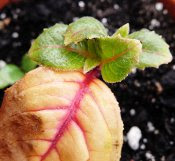Obviously, the more leaves on the cutting, the greater the leaf area, so the more sugars will be produced. Whilst all this seems pretty obvious, there is a problem: Greater leaf area means greater water loss. But without roots, the cutting cannot take up water from the compost. So it can wither and die. A vicious circle.
For this reason, a compromise is reached when taking cuttings. It is standard practice to reduce the number of leaves to just one or two. However, over the years I have consistently noticed two things:
- small leaves are no use at all - they produce very slow growth
- a large leaf area greatly accelerates rooting - and plants can determine this better than we can
'Better than we can? Cripes! Does this mean they can think?'
'Don't be silly. They haven't got a brain!'

 Most growers would be embarrassed to show plants with shrivelled leaves. But I'm encouraged. Why? Well, look at the evidence. These cuttings, taken last week, are really romping away. I don't think they have yet rooted, but that's not important (well, it is - but not here). What I want to show you is how the plants are jettisoning the excess they don't want (the leaves that are changing colour).
Most growers would be embarrassed to show plants with shrivelled leaves. But I'm encouraged. Why? Well, look at the evidence. These cuttings, taken last week, are really romping away. I don't think they have yet rooted, but that's not important (well, it is - but not here). What I want to show you is how the plants are jettisoning the excess they don't want (the leaves that are changing colour).Why not just remove them at the start? Wouldn't this be better?
I don't think so. Even if we didn't remove them, and cut the larger leaves in half (to cut down on water loss), this would also remove any spare sugars lying around in the unwanted leaf. The clever part here is that the cutting can first utilize these sugars, THEN jettison the leaf.
I have found using more leaves to be the best way of taking geranium shoot tip cuttings. First, start with a soil which just binds together when squeezed and is slightly cool to the touch (I use the back of my fingers). Then take the cutting and don't water again as long as there is some sign of green life, especially NEW green life. Watch for new roots at the bottom of the pot. When you DO water, do it from the bottom: stand the pot in a saucer of water for about 10 to 15 minutes.
Of course, everything is not cut and dried. It wouldn't be 'growing' if it were (well, that's not strictly true; it would be growing, but 'growing by numbers'). Because your conditions differ from mine in terms of temperature, humidity, air speed etc., slight adjustments will be needed. But you'll be on the right track. At least, I hope you will.
 Just out of interest, and to consolidate the point somewhat, this fuchsia cutting was taken about a month ago. I know the large leaves are dead (one has already fallen off). But bear in mind it has never been covered. It's been in dry air - even in the sun - the whole time. A seemingly impossible feat. And it's not as if 'Annabel' (it's name) even likes the sun, indicated by the dark red veins. It doesn't. Yet it rooted and is now growing strongly (though uncovered cuttings do take longer to root).
Just out of interest, and to consolidate the point somewhat, this fuchsia cutting was taken about a month ago. I know the large leaves are dead (one has already fallen off). But bear in mind it has never been covered. It's been in dry air - even in the sun - the whole time. A seemingly impossible feat. And it's not as if 'Annabel' (it's name) even likes the sun, indicated by the dark red veins. It doesn't. Yet it rooted and is now growing strongly (though uncovered cuttings do take longer to root).See also: 'A Cut Below Average'
No comments:
Post a Comment